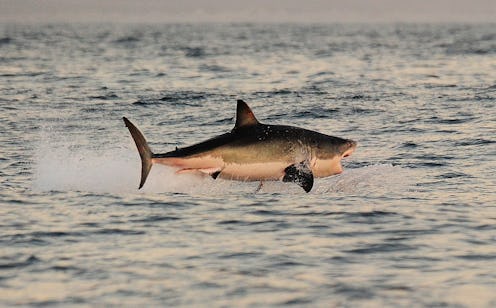News
18 Scary Shark Statistics To Scare Your Friends
Here are the best things about summer, ranked from least to greatest: cookouts, tanning, and Discovery Channel's Shark Week. The network's annual celebration of the great sea beasts is one of the most fun (and, I suppose, most informative) events of the summer. And it’s here once again, to the delight of shark-ophiles everywhere. If you’re obsessively watching Shark Week, take a quick break to check out these awesome shark facts and learn a little more about the fish at the top of the ocean food chain.
Of course, it’s very important to remember that movies like Jaws and The Shallows don’t necessarily portray sharks in the right light. It’s fun to give them a bad rap in Hollywood, but separating the fictional sharks you see from the real thing is critical for their survival. For the most part, sharks don't pose a danger to humans and kinda just want to be left alone.
People are shark's number-one threat, and 20 to 30 percent of all shark species are endangered due to overfishing and/or habitat destruction. Everyone has to remember to be as respectful of their environment as possible, because they are an essential part of the world’s biodiversity. These facts can help you understand more about these fascinating creatures, and why they need to be protected, even if they can be pretty scary.
- Sharks have been in the ocean for about 400 million years, making them some of the oldest species on Earth. They've survived five mass extinction events, including the one that killed the dinosaurs. Basically, they're invincible.
- Most sharks hunt on their own, but the scalloped hammerhead shark does its annual summer migration in schools. Imagine that.
- The largest shark is the whale shark, which can grow to over 60 feet long. 60 feet. Think about that.
- Some sharks eat their siblings in the womb if they need extra nutrients.
- Great white sharks eat 11 tons of food every year.
- Sharks don't see blood; they sense it. Sharks are super-sensitive to electricity changes in the water, and blood changes the conductivity. Basically, sharks get an alert in their senses and race toward the scene.
- That sensitivity comes from small nodules in their noses called the ampullae of Lorenzini. The nodules sense electricity — even pulses as faint as the charges that power a beating heart.
- Unlike most shark species, bull sharks can survive in fresh water, and have been seen thousands of miles inland.
- Most sharks are pretty fast swimmers, and can travel hundreds of miles in a day.
- Shark attacks occur prominently in California because the U.S. government has placed lots of protection on sea lions, seals, and sea otters. Sharks are hunting their natural prey, and humans who get caught in the middle are targeted some times as well.
- The frilled shark is also known as the modern Loch Ness Monster, due to its circular mouth and 300 sharp teeth. But it doesn't hang out in Scotland — its territory is mostly in the Pacific Ocean.
- Sharks have super hearing. Sound waves travel great distances very quickly through water, so sharks can hear things up to 800 feet away.
- The prehistoric Megaladon shark grew to over 60 feet long and had teeth that were seven inches long.
- The Megaladon is thought to be the largest shark ever, but there was another fish called the Dunkleosteus, which, although not technically a shark, weighed about four tons and could have given the Megaladon a run for its money.
- A shark bite can exert about 40,000 pounds per square inch of pressure. For comparison, humans are pretty much maxed out at 286 pounds per square inch.
- Some sharks chew their way out of their eggs when they are born, putting their teeth to work before they've even hatched.
- Sharks keep lobsters alive! Without sharks, the octopus population would skyrocket, and the lobster population would plummet, since octopi love to munch on lobster (who doesn't?)
- The shortfin mako is one of the fastest shark species, and can swim up to 20 miles per hour.
